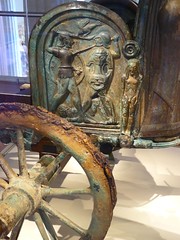
I wish this article had included a picture. I would like to have compared it to this bronze Etruscan chariot I saw at the Metropolitan Museum of Art in New York to see what changes were made in chariot design over 700 years.
"Archaeologists have dug up the skeletons of 16 horses and a two-wheeled chariot in a grave dating back to the Roman Empire in north-east Greece, the culture ministry announced.
Half of the horses were buried in pairs, whilst two human skeletons were also discovered in a dig near Lithohori, in the Kavala region.
Near to the remains of six of the horses archaeologists found a shield, weapons and various other accessories.
Ten of the horse skeletons were complete and in addition to the horses, diggers found a grave and four tombs covered with a ceramic lid, which contained four bronze coins dating back to the fourth century AD.
The chariot, dating from the first or second century AD, was "undoubtedly designed to be used in war or hunting," the ministry said.
The chariot was decorated with a frieze relief in bronze, depicting three of Hercules' labours - namely the Cerberus dog, the wild boar of Erymanthian, and the Stymphalian birds."
